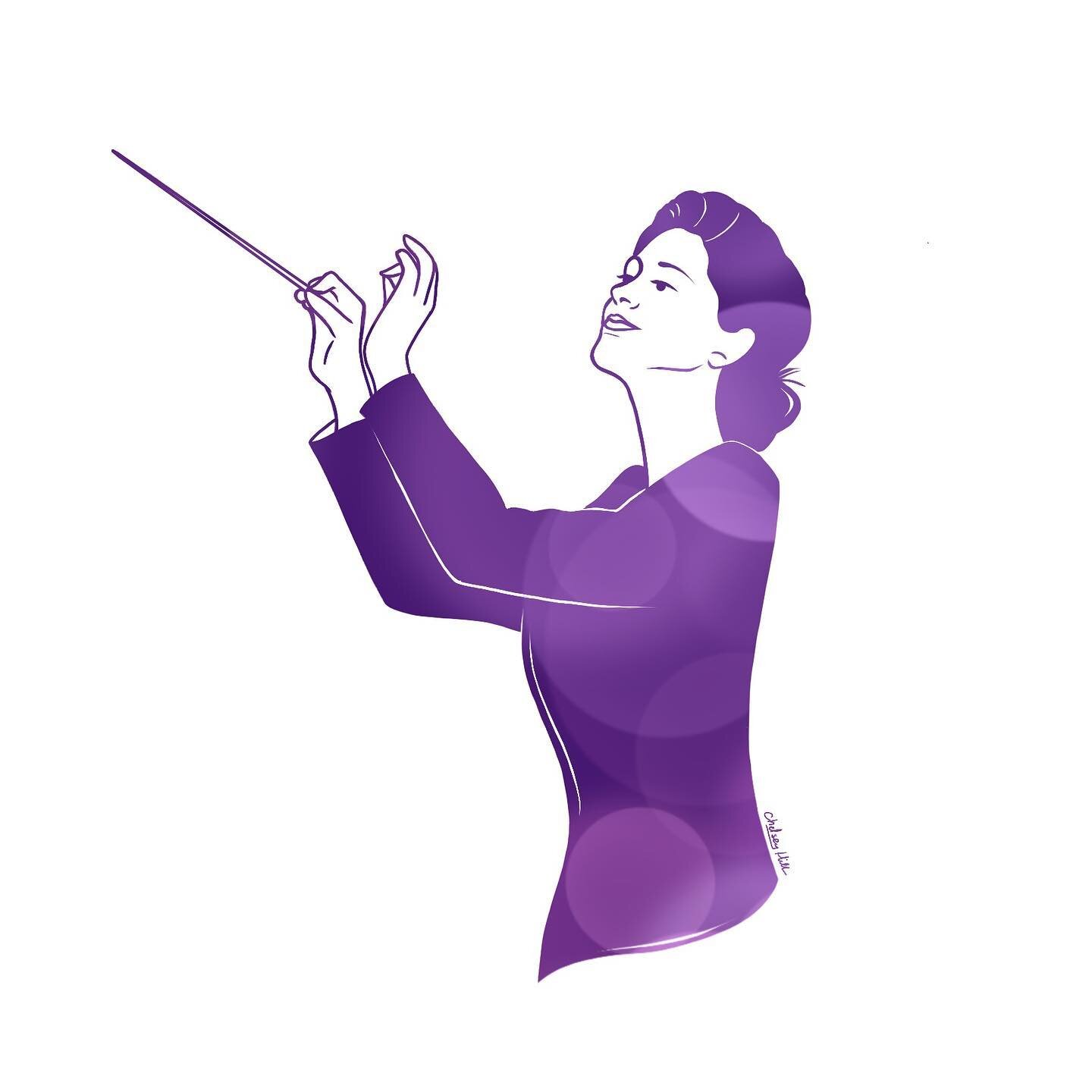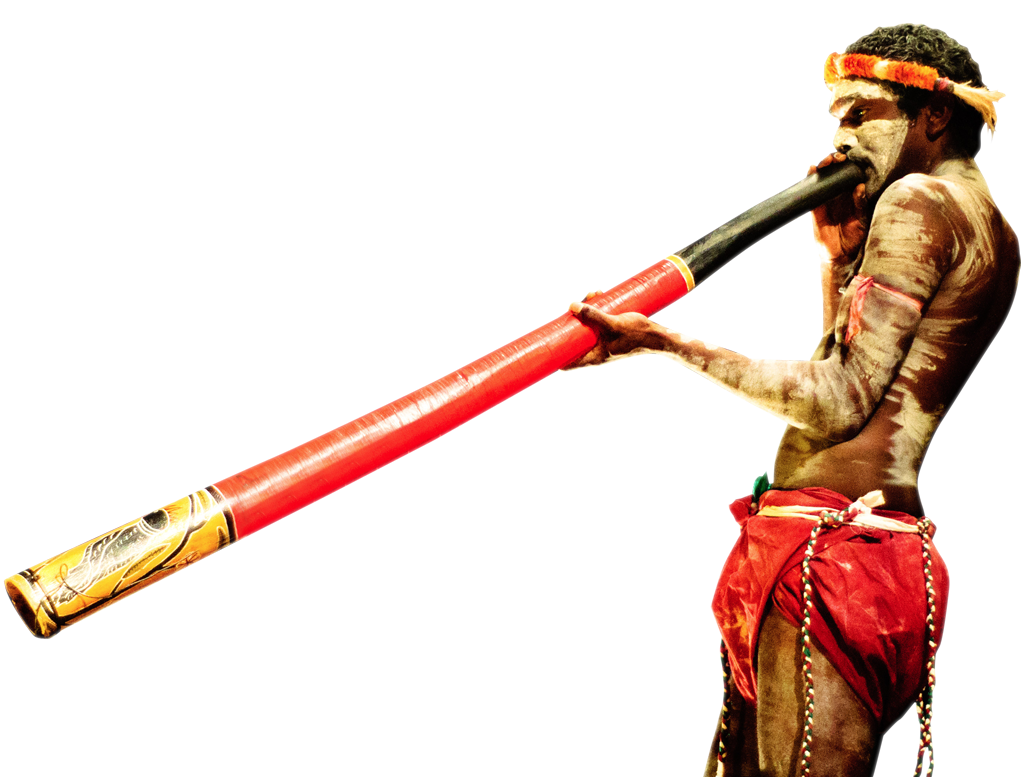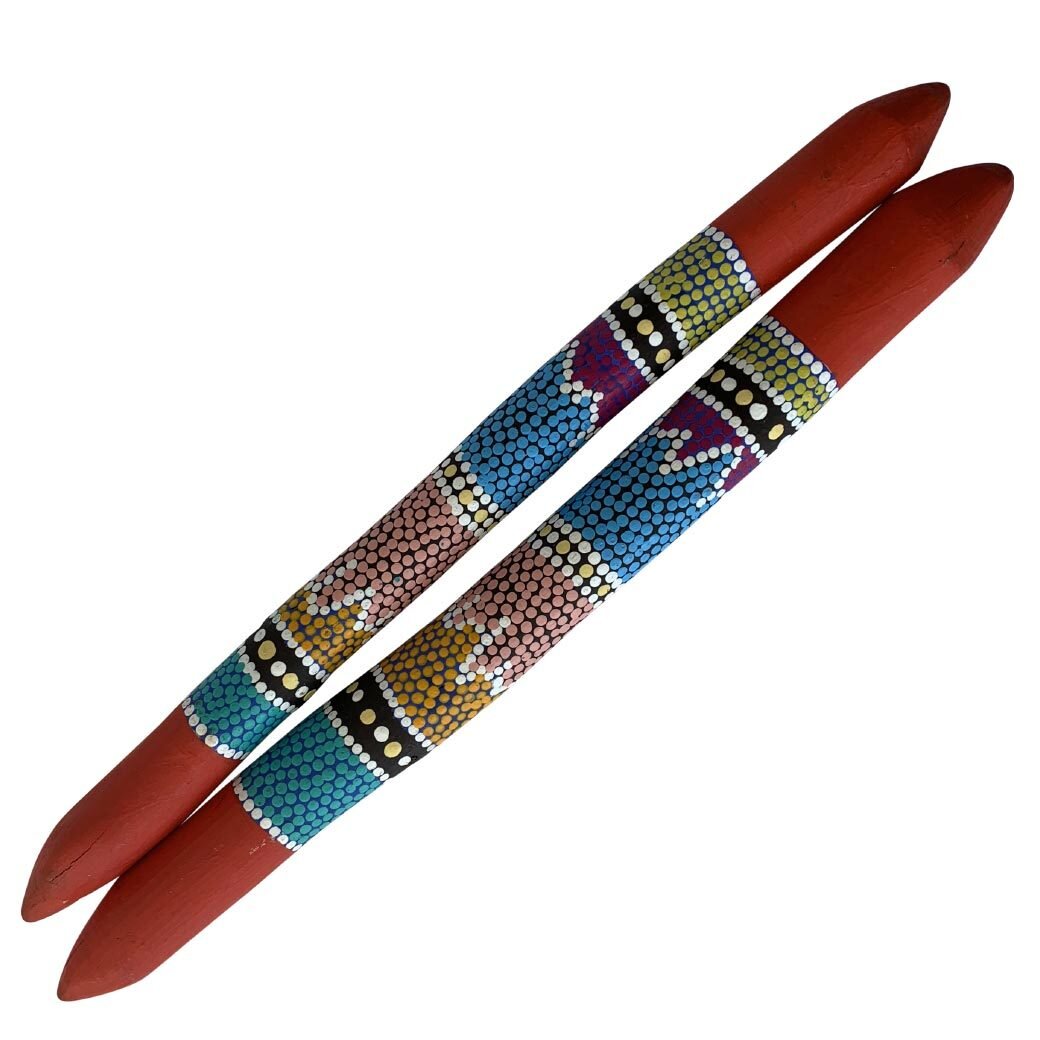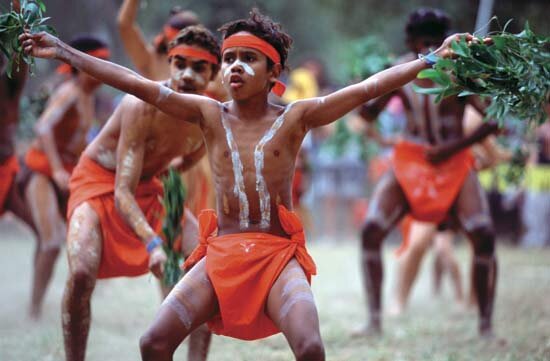WHAT IS ABORIGINAL MUSIC?
The term ABORIGINAL refers to the original inhabitants of any area in the world. Often, the term specifically applies to the indigenous people of the continent of Australia and the Torres Straight Islands (an archipelago of 274 islands off of the north coast of Australia, below Papua New Guinea). Aboriginal Australians should not be confused with aboriginal Canadians who are also known as the First Nations.
Australian Aboriginals and Torres Straight Islanders are grouped into hundreds of distinct clans that have some similarities and many differences among their cultural practices.
CULTURAL PROTOCOL
The Australian Aboriginals and Torres Straight Islanders have endured many hardships as a result of European colonization of their indigenous lands. Today, tribal groups (clans) work hard to rebuild community and traditional practices lost to their ancestors over hundreds of years of forced assimilation. Because of this, many parts of Aboriginal and Torres Straight Islander customs, arts, and musical practices are not shared with Western society as a way to assert autonomy and cultural definition. In the ABORIGINAL AND TORRES STRAIGHT ISLANDER CULTURAL PROTOCOL GUIDELINES, it is explicitly stated that: “Indigenous people have the right to keep secret their sacred and ritual knowledge in accordance with their customary laws” and that: “Secret and sacred material refers to information that is restricted under customary law and so is unsuitable for publication” which includes many types of Aboriginal artwork and music forms.
This provides evidence as to why we - as Western academics - do not always have a full picture of Aboriginal musical practices and, in order to remain respectful of this indigenous culture, should not seek knowledge of practices that is not given freely by the people who practice this tradition.
SONGLINES & DREAMING
Aboriginal Australians are deeply in touch with their ancestors and traditional practices. Music and song are greatly connected with these practices and help Aboriginal people to connect more closely to “DREAMING.” The concept of Dreaming, The Dreaming, or Dreamtime is quite complicated and differentiated between different Aboriginal populations across Australia. It encompasses creation myths, religion, pre-life/life/death, historical events, connection to ancestors and deity, and other important life events. To access this information or receive spiritual revelation, Aboriginals will engage in SONGLINES, song cycles of specific songs sung by travelers in order, to help them travel long distances across Australia by using markers in the songs as musical maps.
Songlines Explained (360 Video)
ABORIGINAL INSTRUMENTS
DIDGERIDOO | YIDAKI
By far the most famous instrument and musical genre to take the world stage from Australia is the DIDGERIDOO (Didjeridu). The instrument is constructed from nothing more than a hollow tree trunk (most traditionally, a eucalyptus trunk hollowed by termites) and some wax along the end one blows into. The Didgeridoo can be CYLYNDRICAL (same circumference down the entire length) or CONICAL (growing wider or flaring out at the end). The word Didgeridoo/Didjeridu is a non-indigenous word created through onomatopoeia (when a word sounds like the sound). The indigenous names for the instrument include YIDAKI, MANDAPUL, and MAGO depending on the region of Australia. Players buzz their lips while blowing into the wax mouthpiece like one would play a brass instrument. Didgeridoo musicians also utilize CIRCULAR BREATHING, a concept where one breathes in through the nose and out through the mouth simultaneously so the sound of the Didgeridoo never stops. The Didgeridoo’s timbre is thick, flat, and resonant.
CLAPSTICKS | BILMA | WIRRI
CLAPSTICKS are the main percussion instrument in Aboriginal music-making. They are generally built in matching sets and are carved from the hard heartwood of a brach or tree trunk. Clapsticks can be simple or ornately decorated as the ones in this image. Often, a single didgeridoo player may hit the body of their didgeridoo with a clapstick to create a rhythmic element in addition to the rhythm of the didgeridoo.
BULLROARER
The BULLROARER is the generic term for this instrument often associated with Aboriginal culture. The Aboriginal name for the instrument as well as its specific uses are unknown to ethnomusicologists as this is one of the more sacred instruments that Aboriginals have chosen not to share with the rest of the world. The generic bullroarer is constructed of an oblong wooden disc attached to the end of a rope. When spun in a circular fashion, the rope tightens and loosens as it twists and this results in a hum that rises and falls in pitch as the rope cuts through the air. We do know that only Aboriginal men are allowed to play it and that it is associated with some religious ceremonies including burials (honoring the dead is considered extremely sacred in Australia).
GUM LEAF
The GUM LEAF is nothing more than a leaf off a Eucalyptus tree that the player holds firmly within the opening of their mouth and plays with a combination of fast air and lip action. This is similar to the childhood pastime of making whistles out of wide blades of grass and is technically a single reed instrument (like a clarinet or saxophone). While the Gum Leaf is played mostly in modern times as a melodic instrument for pleasure, it is believed that in earlier eras, it was also used as a bird call by hunters or a way to signal to clan members across distances. Practitioners of Gum Leaf can play very loud and accurate notes and full melodies on a single leaf. The Gum Leaf is reedy, abrasive, and piercing.
Aboriginal Crane Dance
DANCE
Aboriginal dance is often choreographed in groups with members performing identical or similar motions with one another. Many of the dances act out the movement of animals, nature, or the motions of activities in life. Dance is usually accompanied by a singer, didgeridoo, and rhythm sticks. The dance motions are, for the most part, heavy, jerky, and energetic.
ORAL TRADITION
All aspects of Aboriginal music are passed down from one generation to the next in keeping with the oral tradition of learning by listening. There is no written music notation in indigenous Australia. It is important for many songs and rituals to be learned and repeated precisely while others have room to improvise. With forced European assimilation in the 19th and 20th centuries, oral tradition has become increasingly difficult to keep music tradition alive.
MUSICAL ELEMENTS OF ABORIGINAL MUSIC
RHYTHM: The rhythms of Aboriginal Australian music, in general, remain consistent within a piece of music without accelerating or decelerating. Musicians will, however, utilize the concept of DOUBLE TIME (playing the music exactly twice as fast) and HALF TIME (playing the music exactly half as fast) to add or remove energy and speed from a piece of music in key places. The main instruments responsible for rhythm are the Clapsticks and Didgeridoo.
MELODY: Melodies are only present in the singing voice and gum leaf when played melodically. The melodies tend to be simple, repetitive, and symmetrical with complimentary phrases that balance rising with falling and vice versa. Range and pitch is limited and melodies are generally performed by a single vocalists or multiple in unison. With a wide range of clan diversity, not every group will adhere to these generalizations.
HARMONY: There is no harmony in traditional Aboriginal music as all melodic lines are solo or unison.
TIMBRE: The preferred vocal timbre of Aboriginal singers can vary from clan to clan but tends to be guttural, raspy, and nasally. Between the voice and accompanying Didgeridoo, a thick, guttural, flat texture of sound emerges.
DYNAMICS: Dynamics are consistent within specific pieces (generally all loud or all soft) and dynamic pitch may shift with rhythm shifts: increasing with faster rhythms and decreasing with slower rhythms.
TEXTURE: With the Didgeridoo serving as a drone under a vocalized melody, the texture of most traditional Aboriginal music should be considered monophonic as there is only one melody, no harmony, and the drone is creating a canvas behind the melody but not interacting in any real way.
FORM: There are no specific forms of note in Aboriginal music as this varies so greatly from song to song and from tribe to tribe.
COSTUME
There is generally no specific attire worn by Australian Aboriginals when making music and they wear what they normally would on a given day. Due to the hundreds of different clan traditions, this may not be true for every clan. Cloaks are worn by clans in the cooler southern parts of Australia while loin cloth-like LAP-LAPS made of plant fibers or animal skin are worn by many tribes during music-making, dance, and other activities. Body and face painting is also a common practice among many clans.
CONTEMPORARY ABORIGINAL ARTISTS
“Marryuna” by Baker Boy feat. Yirrmal
In order to modernize traditions as well as gain visibility for traditional ways, many young Aboriginal artists combine the music of their heritage with mainstream country, pop, rock, and rap. Country music, especially, has served as a great “popular” outlet for Aboriginal musicians to express their hardships.
Famous modern artists include WARUMPI BAND, THE MEDICS, YOTHU YINDI, EMILY WURRAMARA, and BAKER BOY.
WHERE TO HEAR ABORIGINAL MUSIC IN THE USA …
Unfortunately, most authentic Aboriginal music in the United States is presented in academic and educational realms rather than for the pure enjoyment of music. Because of this, most performances are located at museums or academic institutions in a type of presentation known as a LECTURE RECITAL where a musician will simultaneously perform their music and explain to the audience what it is about or what they are doing between musical numbers. Very few non-indigenous musicians perform authentic Australian Aboriginal music and there are very few Australian Aboriginal people living in the United States.
The Didgeridoo is an instrument that has captivated musicians and non-musicians all over the world but the instrument is often appropriated into fusion or new styles that do not present an authentic rendering of the traditional use of the instrument. Still, it is not uncommon to find non-indigenous didgeridoo BUSKERS (people who play music on the street for money) in crowded tourist locations, at alternative art/spiritual/music festivals, or on college campuses.







